CADILLAC SEVILLE 1996 4.G Owners Manual
Manufacturer: CADILLAC, Model Year: 1996, Model line: SEVILLE, Model: CADILLAC SEVILLE 1996 4.GPages: 354, PDF Size: 20.21 MB
Page 231 of 354
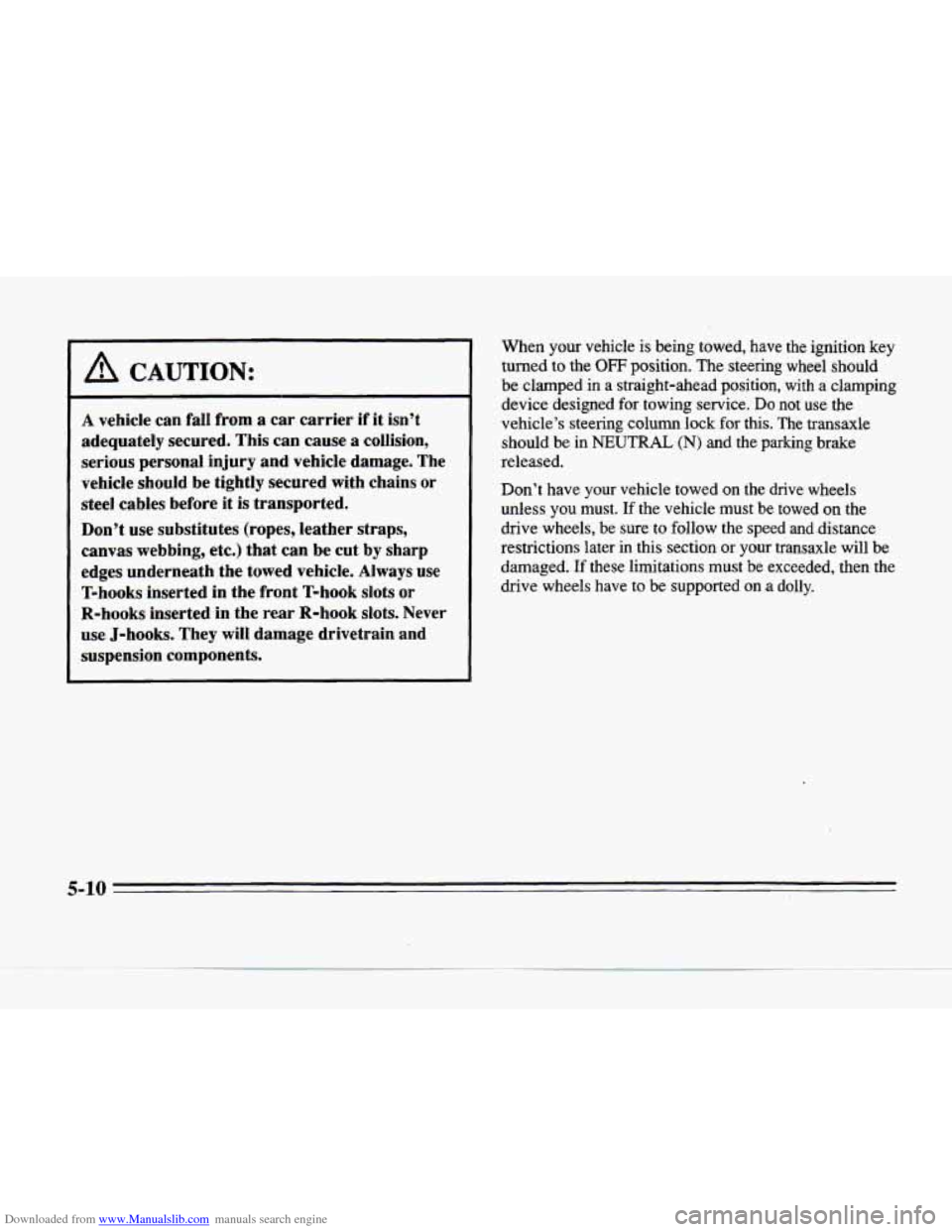
Downloaded from www.Manualslib.com manuals search engine ~ A CAUTION:
A vehicle
can fa11 from a car carrier if it isn’t
adequately secured. This can cause a collision,
serious personal injury and vehicle damage. The
vehicle should be tightly secured with chains
or
steel cables before it is transported.
Don’t use substitutes (ropes, leather straps,
canvas webbing, etc.) that can
be cut by sharp
edges underneath the towed vehicle. Always use
T-hooks inserted in
the front T-hook slots or
R-hooks inserted in the rear R-hook slots. Never
use J-hooks. They will damage drivetrain
and
suspension components. When
your vehicle is being towed, have the ignition key
turned to the
OFF position. The steering wheel should
be clamped in a straight-ahead position, with a clamping
device designed for towing service.
Do not use the
vehicle’s steering column lock
for this. The transaxle
should
be in NEUTRAL (N) and the parking brake
released.
Don’t have your vehicle towed on the drive wheels
unless you must. If the vehicle must be towed on the
drive wheels, be sure to follow the speed
and .distance
restrictions later
in this section or your transaxle will be
damaged. If these limitations
must be exceeded, then the
drive wheels have to be supported on
a dolly.
Page 232 of 354
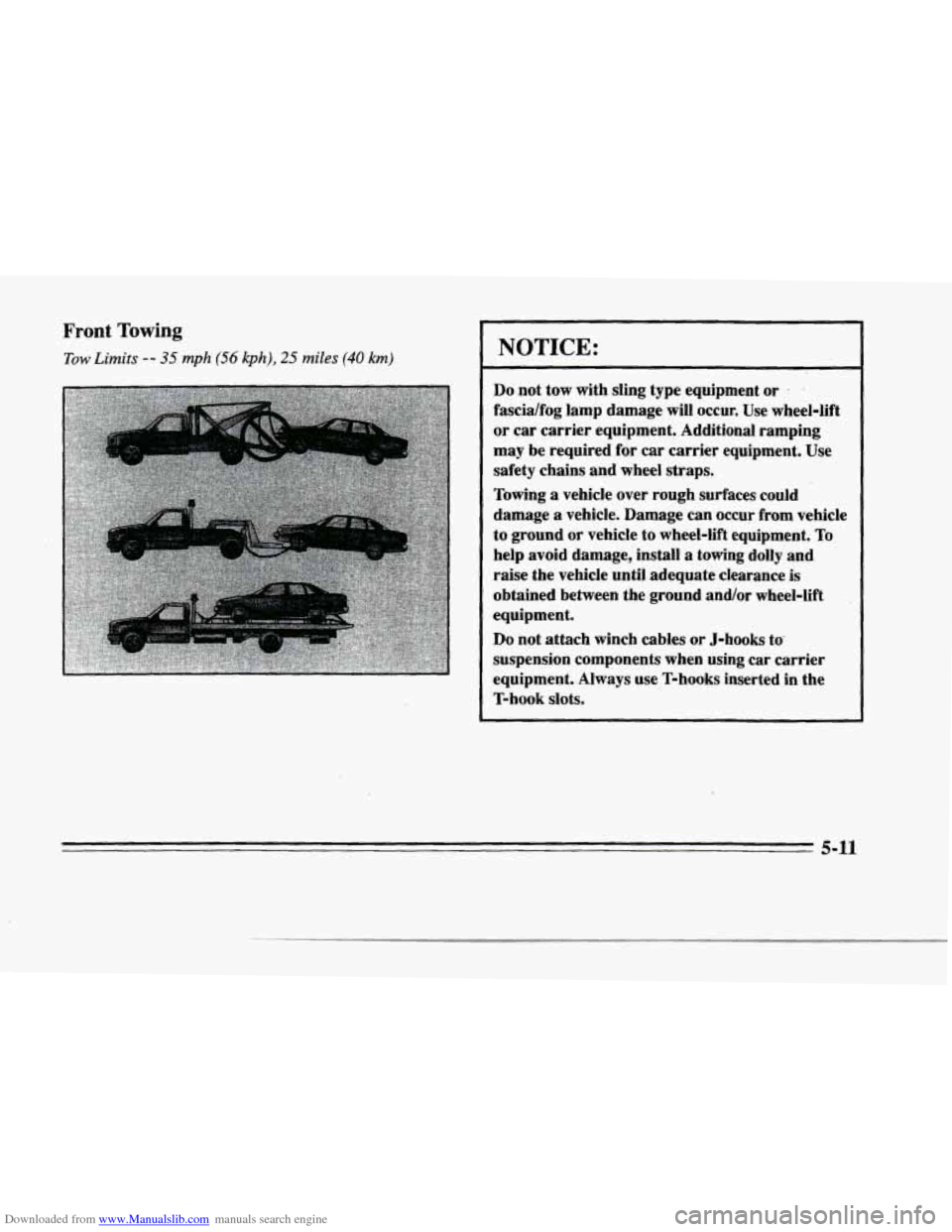
Downloaded from www.Manualslib.com manuals search engine r Front Towing
Tow Limits -- 35 mph (56 kph), 25 miles (40 km)
f
t
p"
I
i
f
NOTICE:
Do not tow with sling type equipment or - .
fascidfog lamp damage will occur. Use wheel-lift
or car carrier equipment. Additional ramping
may be required for car
carrier equipment. Use
safety chains and wheel straps.
Towing
a vehicle over rough surfaces could
damage
a vehicle. Damage can occur from vehicle
to ground
or vehicle to wheel-lift equipment. To
help avoid damage, install a towing dolly and
raise the vehicle until adequate clearance
is
obtained between the ground andlor wheel-lift
equipment.
Do not attach winch cables or J-hooks to'
suspension components when using
car carrier
equipment. Always use T-hooks inserted in the
T-hook Slots.
..
5-11
Page 233 of 354
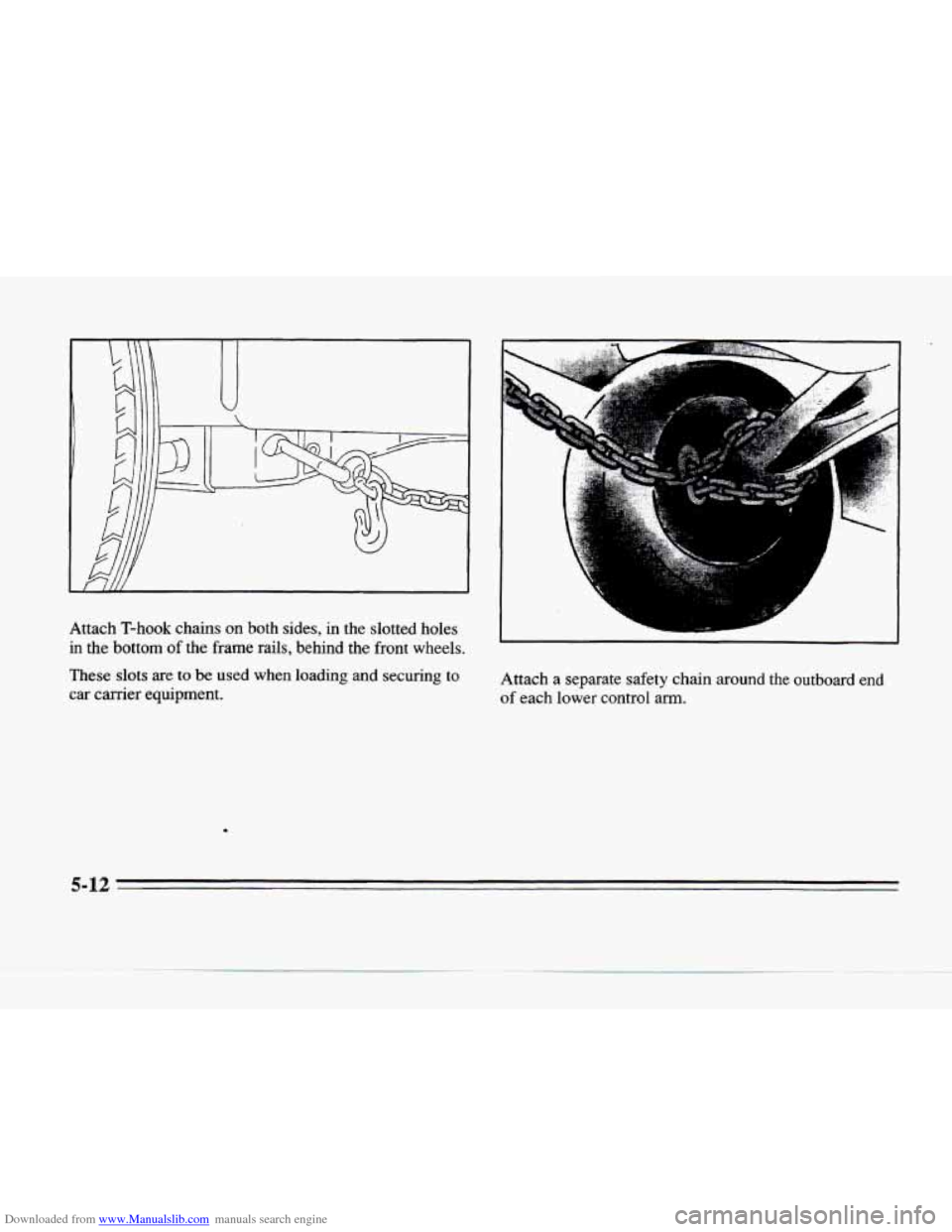
Downloaded from www.Manualslib.com manuals search engine Attach T-hook chains on both sides, in the slotted holes
in the bottom of the frame rails, behind the front wheels.
These slots
are to be used when loading and securing to
car carrier equipment. Attach a separate safety chain around the outboard end
of each lower control arm.
5-12
i
Page 234 of 354
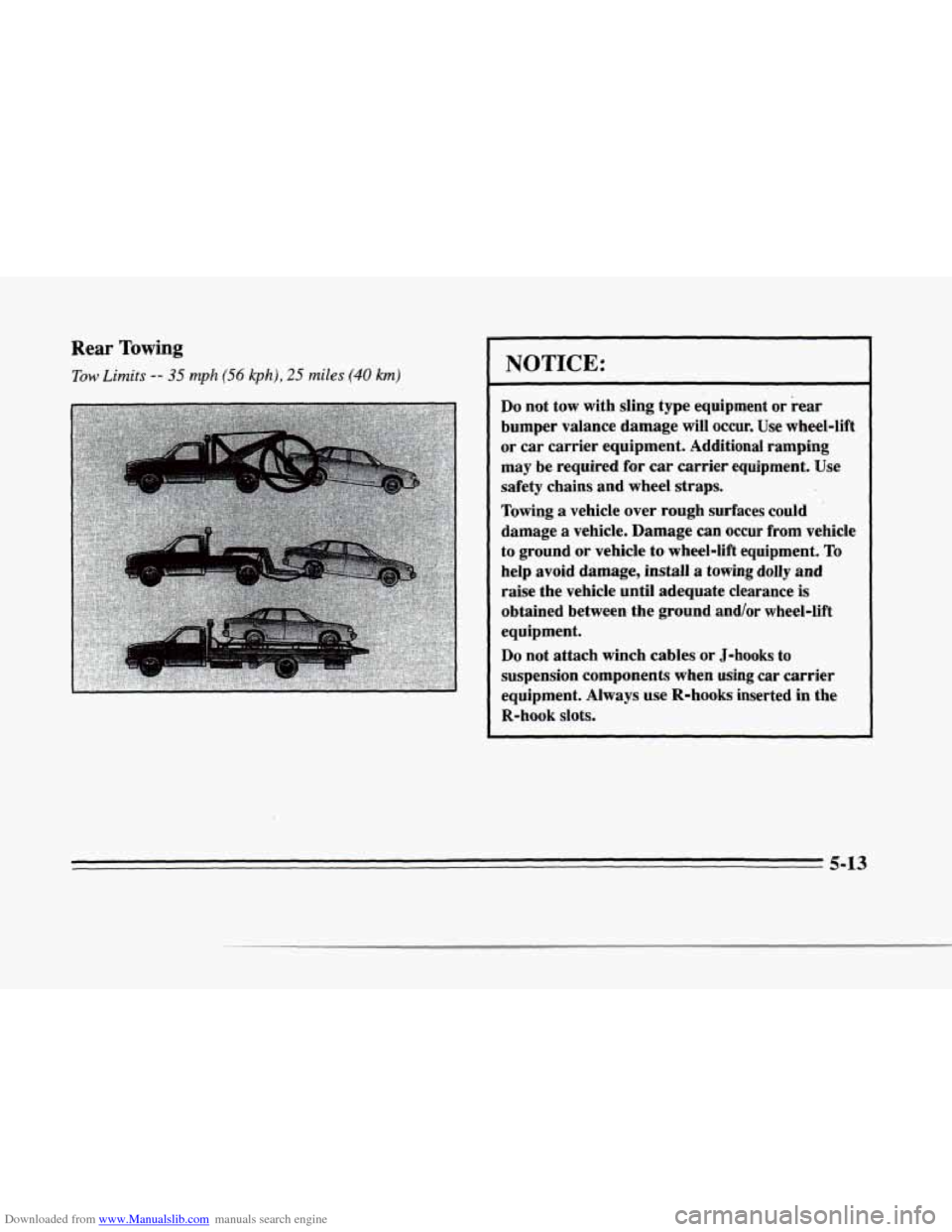
Downloaded from www.Manualslib.com manuals search engine P
f .-
?- I /
Rear Towing
Tow Limits -- 35 mph (56 kph), 25 miles (40 km) NOTICE:
Do not tow with sling type equipment or rear
bumper valance damage will occur. Use wheel-lift
or car carrier equipment. Additional ramping
may be required for car carrier equipment. Use
safety chains and wheel straps.
Towing
a vehicle over rough surfaces could
damage
a vehicle. Damage can occur from vehicle
to ground or vehicle
to wheel-lift equipment. To
help avoid damage, install a towing dolly and
raise the vehicle until adequate clearance
is
obtained between. the ground and/or wheel-lift
equipment.
Do not attach winch cables'or J-hooks to
suspension components when using car carrier
equipment. Always use R-hooks inserted in the
R-hook slots.
5-13
Page 235 of 354
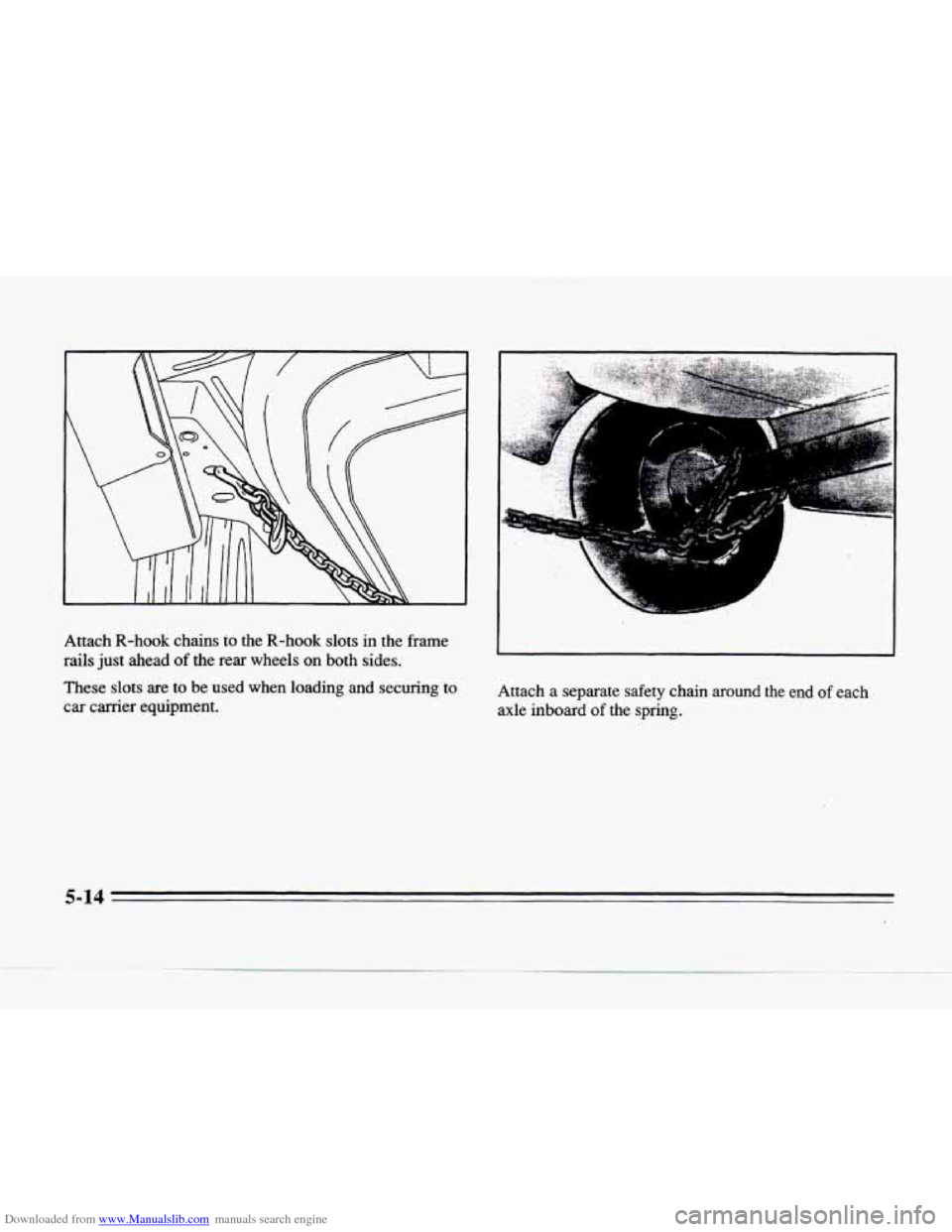
Downloaded from www.Manualslib.com manuals search engine Attach R-hook chains to the R-hook slots in the frame
rails just ahead
of the rear wheels on both sides.
These slots
are to be used when loading and securing to
car carrier equipment. Attach
a separate safety chain around the end of each
axle inboard
of the spring.
5-14
a
'c
Page 236 of 354
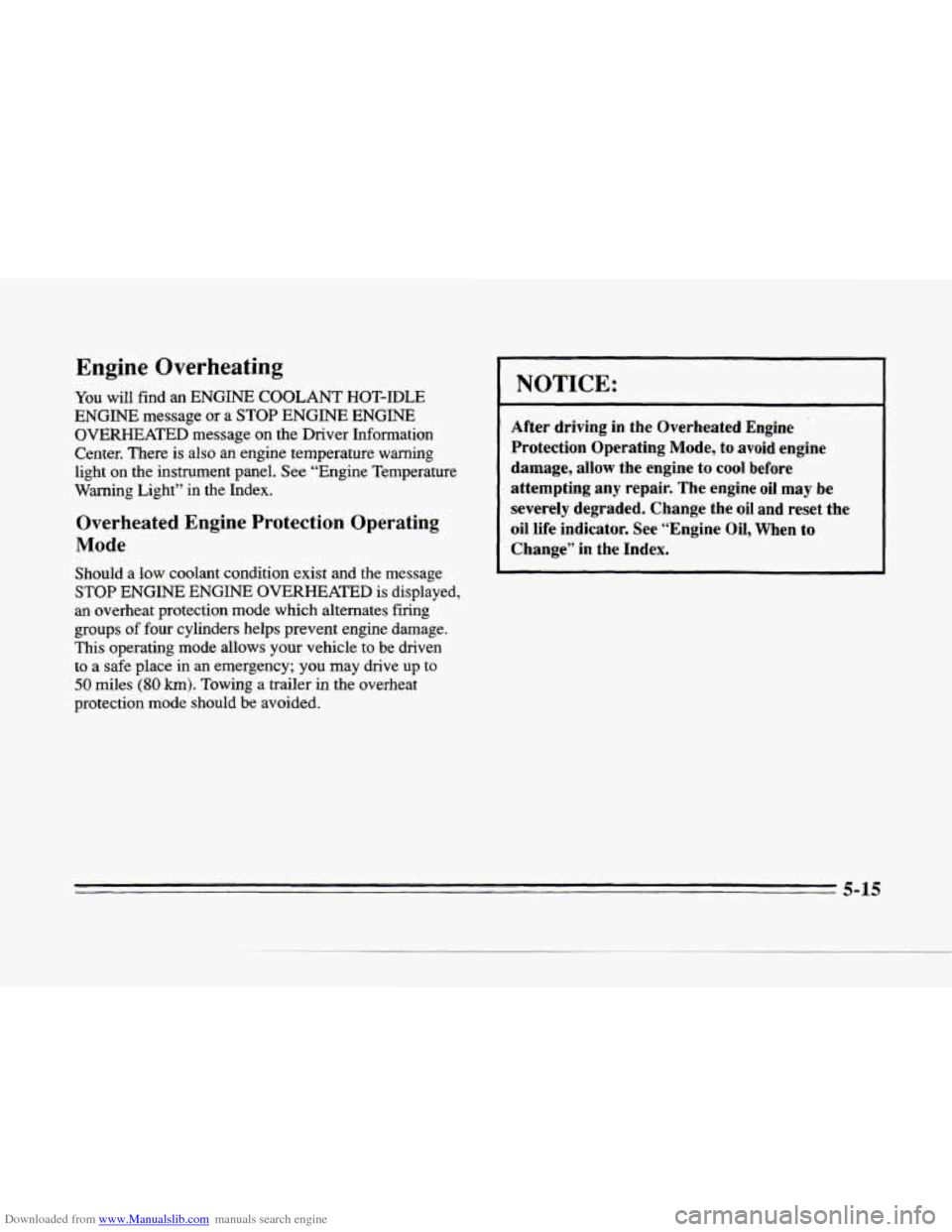
Downloaded from www.Manualslib.com manuals search engine L
rc
Engine Overheating
You will find an ENGINE COOLANT HOT-IDLE
ENGINE message
or a STOP ENGINE ENGINE
OVERHEATED message on the Driver Information
Center. There is also an engine temperature warning
light on the instrument panel. See “Engine Temperature
Warning Light”
in the Index.
Overheated Engine Protecaon Operating
Mode
Should a low coolant condition exist and the message
STOP ENGINE ENGINE OVERHEATED is displayed,
an overheat protection mode which alternates firing
groups
of four cylinders helps prevent engine damage.
This operating mode allows your vehicle
to be driven
to
a safe place in an emergency; you may drive up to
50 miles (80 km). Towing a trailer in the overheat
protection mode should be avoided.
NOTICE:
After driving in the Overheated Engine
Protection Operating Mode, to avoid engine
damage, allow the engine to cool before
attempting any repair. The engine oil may be
severely degraded. Change the
oil and reset the
oil life indicator. See “Engine Oil, When to
Change” in the Index.
5-15
Page 237 of 354
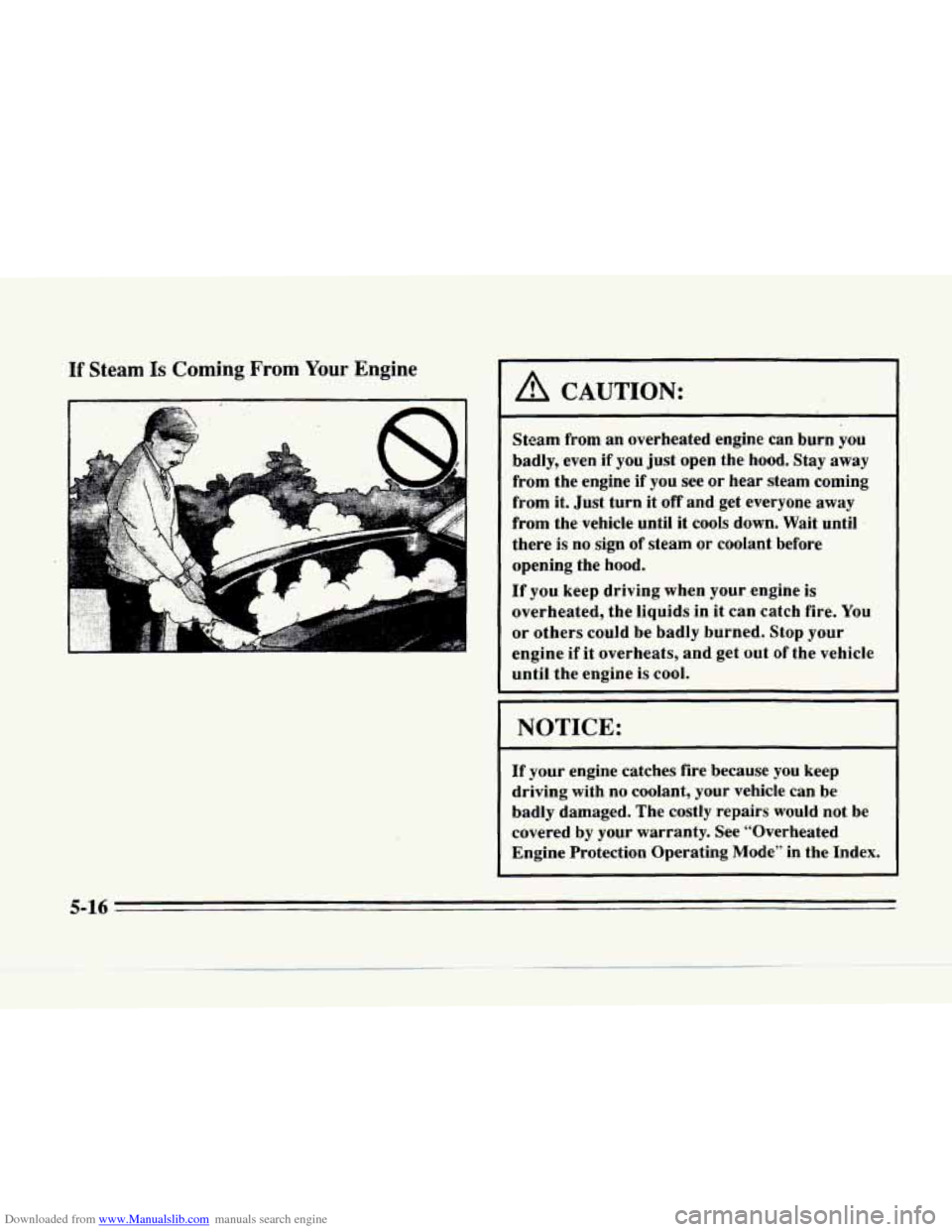
Downloaded from www.Manualslib.com manuals search engine If Steam Is Coming From Your Engine
A CAUTION:
Stcam from an overheated engine can burn you
badly, even if you just open the hood. Stay away
from the engine if you see
or hear steam coming
from it. Just turn it
off and get everyone away
from the vehicle until it cools down. Wait until
there
is no sign of steam or coolant before
opening the hood.
If you keep driving when your engine is
overheated, the liquids in it can catch fire.
You
or others could be badly burned. Stop your
engine if it overheats, and get out of the vehicle
until the engine is cool.
NOTICE:
If your engine catches fire because you keep
driving with no coolant, your vehicle can
be
badly damaged. The costly repairs would not be
covered by your warranty. See “Overheated
Engine Protection Operating Mode” in the Index.
c
5-16
Page 238 of 354
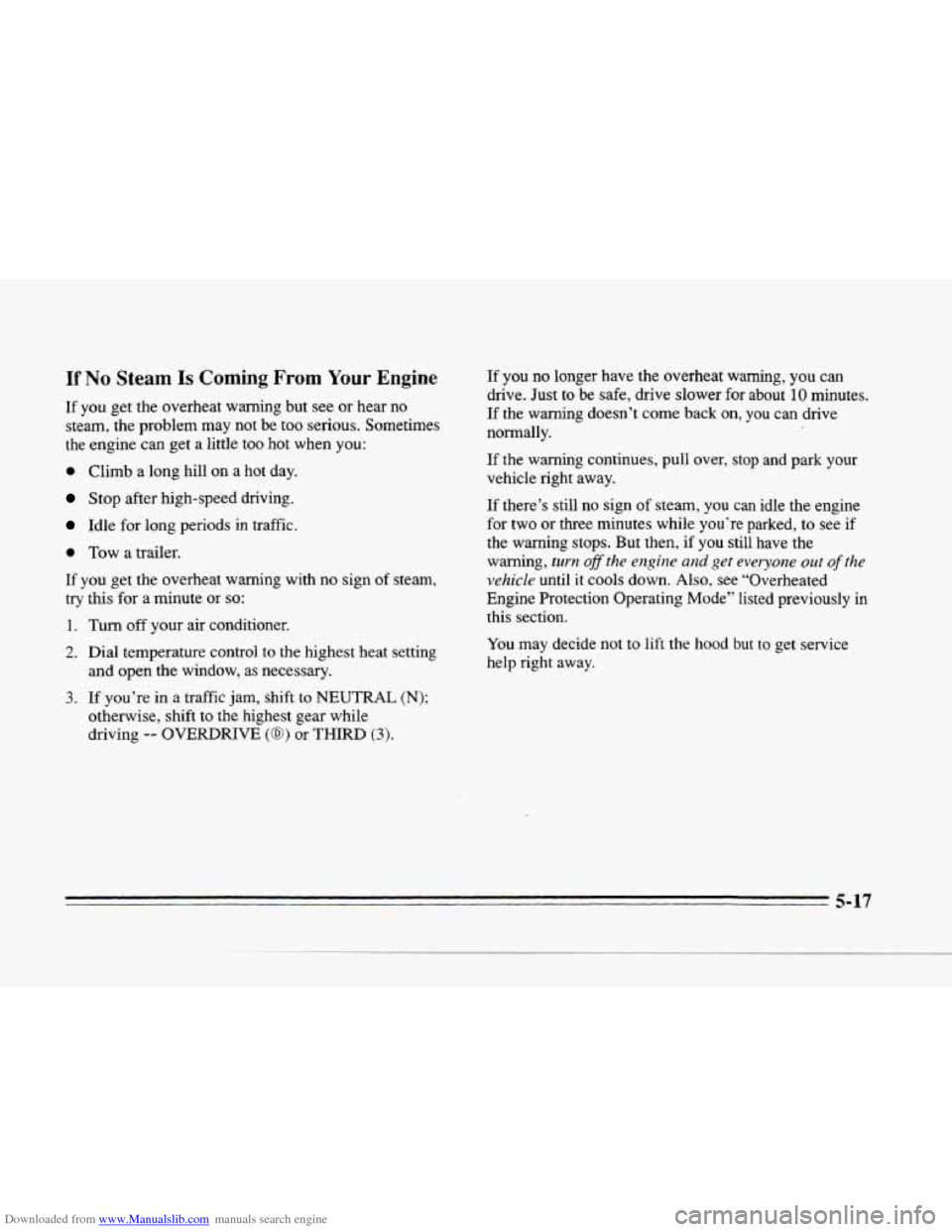
Downloaded from www.Manualslib.com manuals search engine rc
.-,
If No Steam Is Coming From Your Engine
If you get the overheat warning but see or hear no
steam, the problem may not be too serious. Sometimes
the engine
can get a little too hot when you:
0 Climb a long hill on a hot day.
Stop after high-speed driving.
Idle for long periods in traffic.
0 Tow a trailer.
If you get the overheat warning with no sign
of steam,
try this for a minute or so:
1. Turn off your air conditioner.
2. Dial temperature control to the highest heat setting
3. If you’re in a traffic jam, shift to NEUTRAL (N);
and open the window, as necessary.
otherwise, shift to the highest gear while
driving
-- OVERDRIVE (a) or THIRD (3).
If you no longer have the overheat warning, you can
drive. Just to be safe, drive slower for about
10 minutes.
If the warning doesn’t come back on,
you can drive
normally.
If the warning continues, pull over, stop and park your
vehicle right away.
If there’s still no sign of steam, you can idle the engine
for two or three minutes while you’re parked, to see if
the
warning stops. But then, if you still have the
warning,
turn oflthe engine and get everyone out of the
vehicle until it cools down. Also, see “Overheated
Engine Protection Operating Mode” listed previously in
this section.
You may decide not to lift the hood
but to get service
help right away.
Page 239 of 354
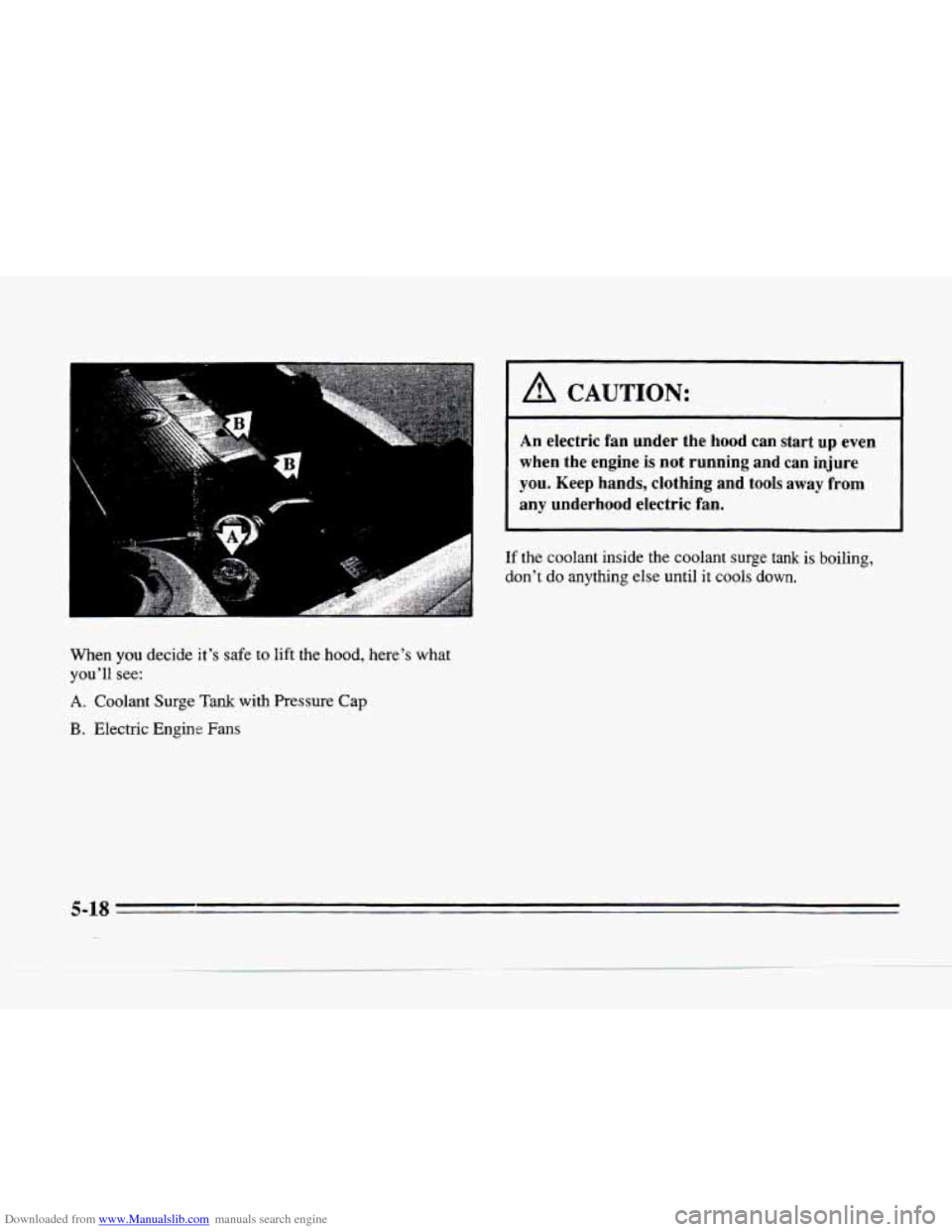
Downloaded from www.Manualslib.com manuals search engine When you decide it's safe to lift the hood, here's what
you'll see:
A. Coolant Surge Tank with Pressure Cap
B. Electric Engine Fans
I A CAUTION:
An electric fan under the hood can start PIP even
when the engine is
not running and can injure
you. Keep hands, clothing and tools away from
any underhood electric fan.
If the coolant inside the coolant surge tank is boiling,
don't do anything else until
it cools down.
5-18
h
Page 240 of 354
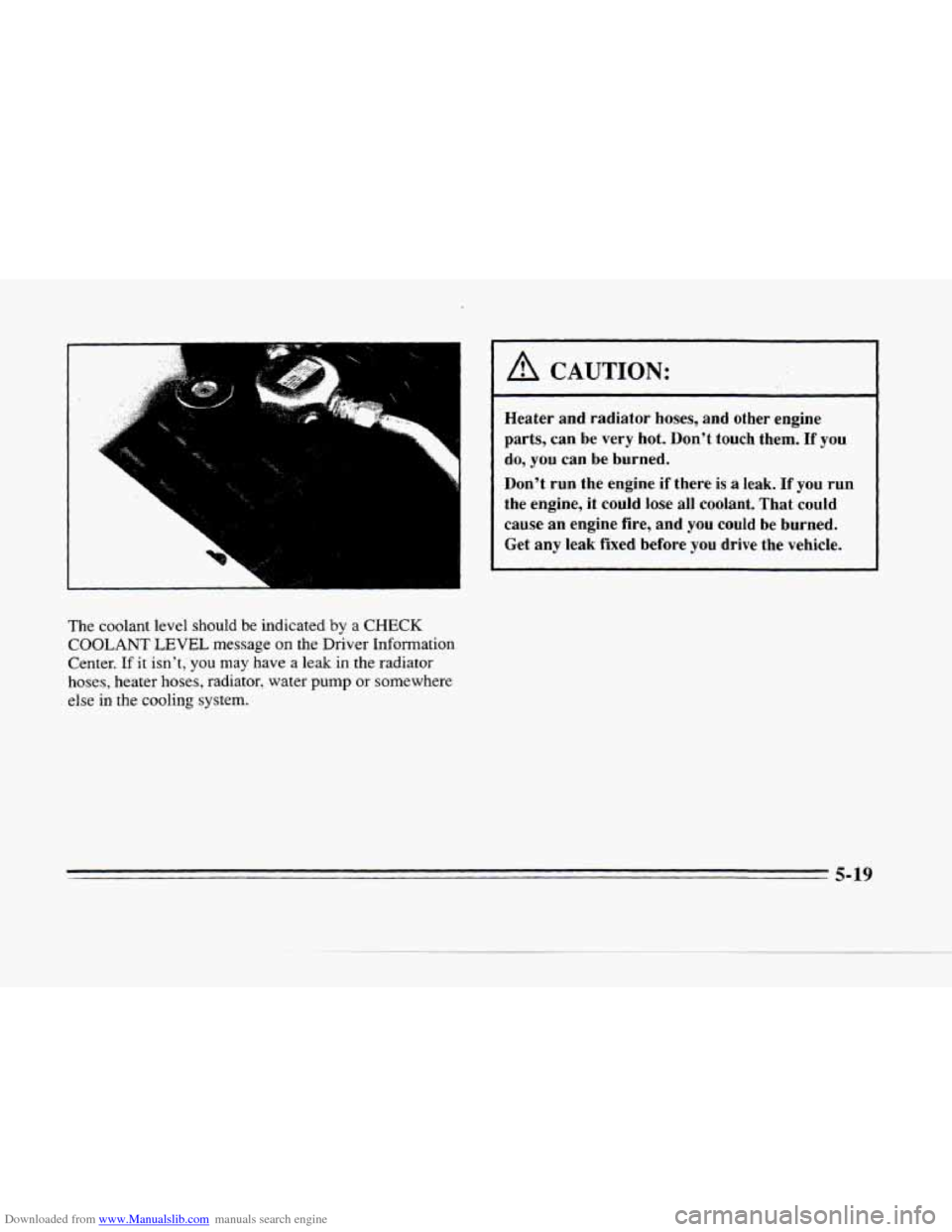
Downloaded from www.Manualslib.com manuals search engine L
L
4
-,. .
The coolant level should be indicated by a CHECK
COOLANT LEVEL message on the Driver Information
Center.
If it isn't, you may have a leak in the radiator
hoses, heater hoses, radiator, water
pump or somewhere
else in the cooling
system.
A CAUTION:
Heater and radiator hoses, and other engine
parts, can be very hot. Don't
touch them. If you
do, you can be burned.
Don't run the engine if there
is a leak. If you run
the engine, it could lose all coolant. That could
cause
an engine fire, and you could be burned.
Get any leak fixed before you drive the vehicle.
5-19